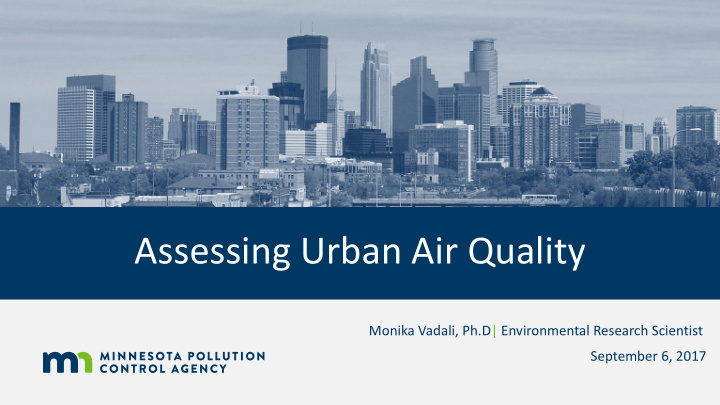



Assessing Urban Air Quality Monika Vadali, Ph.D| Environmental Research Scientist September 6, 2017
The Game Plan • Why we’re doing this • About the project • What we need from you 9/19/2017 2
Why are we doing this? To better understand Availability of newer The Minnesota Cost-saving in the small-scale sensor technology to Legislature provided long run differences in urban monitor air quality funding* air quality LCCMR: Legislative- Citizen Commission on Minnesota’s Resources 9/19/2017 3
About the project The Assessment of Urban Air Quality project will be launched in January, 2018
The nuts and bolts • 50 air quality monitors • At least 1 in each Minneapolis and St. Paul ZIP code • Sensors will be placed on Xcel utility poles at 8-10ft high • Monitoring will be conducted for 2 Your input will help us decide where to install monitors years 9/19/2017 pca.state.mn.us/urbanair 5
What are we monitoring? Fine particles (PM 2.5 ) A mix of solid particles and liquid droplets in the air – • Nitrogen oxides (NO x ) 30x smaller than a human hair • Sulfur dioxide (SO 2 ) • Carbon monoxide (CO) Ground-level Ozone When chemicals and other pollutants mix with sunlight and heat – aka “smog” 9/19/2017 6
Our current monitoring network Our current monitoring system gives us a regional look at how Minnesota compares to other states.
Current Monitors • If you use photos, • Expensive & big maps or charts, make • Strict EPA guidance for them big placement & maintenance • The MPCA has • Regional-scale monitoring collection of photos organized by topic: • Main purpose: www.flickr.com/phot Regulatory os/mpcaphotos/sets/ Air Quality Index Trends over time 9/19/2017 Optional Tagline Goes Here | mn.gov/websiteurl 8
9/19/2017 Optional Tagline Goes Here | mn.gov/websiteurl 9
Main purpose of current monitors: Does Minnesota meet federal & state air quality standard benchmarks?
The new sensors Quick install Little maintenance Solar-powered 9/19/2017 pca.state.mn.us/urbanair 11
Study area
Why Minneapolis and St. Paul? Disparities in air pollution-related health impacts in the metro area • Rates of hospitalizations & emergency department visits • Rates of asthma Asthma rates for children living in the Twin Cities metro are 67% higher than for children living in Greater Minnesota. 9/19/2017 pca.state.mn.us/urbanair 13
Health effects of concern Asthma Hospitalizations by ZIP code All ages, 2009-2013 9/19/2017 14
Data will inform air quality concerns 9/19/2017 pca.state.mn.us/urbanair 15
Partners and Collaborators • Minnesota Department of Health • City of Minneapolis • City of Saint Paul • Minnesota State University, Mankato • Xcel Energy 9/19/2017 pca.state.mn.us/urbanair 16
Is there a specific location you would like to see a monitor? Grab a dot! Dense residential Near schools, daycares Near parks and neighborhoods and senior housing outdoor recreation 9/19/2017 pca.state.mn.us/urbanair 17
Thank you! Monika Vadali, Ph.D Monika.Vadali@state.mn.us www.pca.state.mn.us/urbanair
Recommend
More recommend